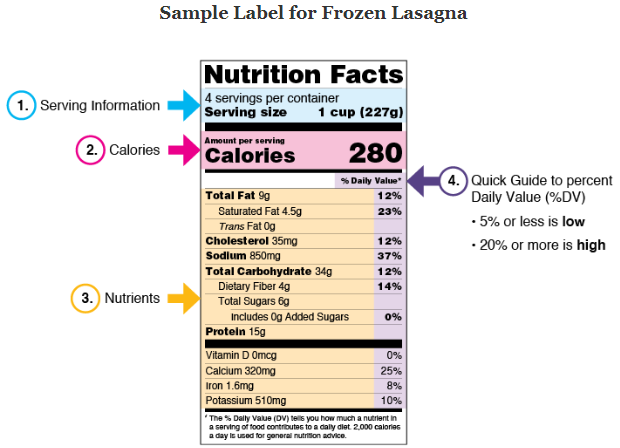Reading a food label may seem overwhelming, however if you know what you are looking for, they are quite user friendly.
Food labels provide important information and can assist in keeping you on track and one step closer to meeting your goals! Below is a sample with basic instructions on how to interpret the numbers on a label. In general, a food label will provide you with the serving size, calories per serving, basic macronutrients (carbohydrate, protein, fat) in grams or milligrams, and a quick guide to the percentage of the daily recommended value for a select group of nutrients.
Step 1 – Serving Information:
Look at serving size! The number of servings in the package or container is usually given by standard measurements, such as cups or ounces. The serving size is the amount that a person would typically eat or drink, not necessarily how much you should eat or drink. In the example above 2 servings of lasagna = 2 cups
Step 2 – Calories:
Notice the caloric content. Calories are a measure of how much energy you get from eating a serving of food or drink. In this example a cup of lasagna provides 280 calories, two cups would provide 560 calories. An individual’s daily caloric requirement is determined by a variety of factors such as: Resting metabolic rate (RMR), physical activity, thermogenesis (calories required for heat production) etc. Keep in mind, if you are at a healthy weight you need to maintain an overall neutral balance (calories in = calories out). If you are trying to lose weight you need to have a deficit. Yes, calories in versus calories out does matter, but the percentage of each macronutrient you consume can impact the ease at which you lose weight. More on that in another blog post!
Step 3 – Nutrients:
Highlights some key nutrients that are important in impacting health. Here you can get an idea of the macronutrient breakdown (protein, carbohydrates, fats), as well as cholesterol, sodium, added sugars. It’s important to look at the saturated fat, sodium and added sugar as these as nutrients it’s best to get less of. Too much added saturated fat and sodium is linked to cardiovascular disease and high blood pressure. While eating too much added sugar is linked to obesity and diabetes. Added sugars on the Nutrition Facts label include sugars that are added during the processing of foods (such as sucrose or dextrose), foods packaged as sweeteners (such as table sugar), sugars from syrups and honey, and sugars from concentrated fruit or vegetable juice.
The acceptable macronutrient distribution ranges (AMDR) set forth by the Institute of Medicine of the National Academies recommend that adults get the following daily:
- 45–65% of their calories from carbs

- 20–35% of their calories from fats
- 10–35% of their calories from proteins
In addition limit:
- Added sugars: Less than 10% of calories a day
- Saturated fat: Less than 10% of calories a day
- Sodium: Less than 2,300 milligrams a day
- Fiber: 25 g and 38 g of fiber daily for women and men under the age of 50, respectively, or approximately 14 g of fiber for every 1,000 calories consumed
Step 4 – Percent Daily Value (%DV):
These are reference amounts (expressed in grams, milligrams, or micrograms) of nutrients to consume or not to exceed each day. It is based on a 2,000-calorie diet. Overall, the %DV helps you determine if a serving of food is high or low in a particular nutrient.
If you need assistance starting a weight management plan talk to your provider today! I am available to help you reach your goals in a healthy and sustainable way!


